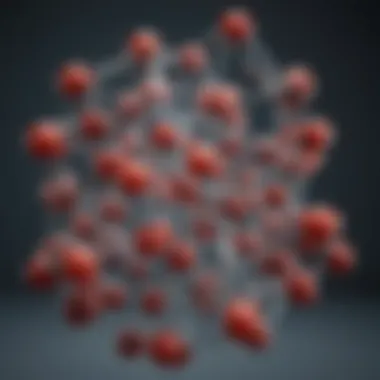Exploring the Streptavidin Conjugation Kit: Uses and Insights


Intro
The streptavidin conjugation kit holds a pivotal position within the realm of molecular biology. This versatile tool, celebrated for its ability to facilitate biotin-protein interactions, serves as a foundation for numerous experimental processes spanning biochemistry, genetics, and microarray analysis. Its functionality hinges on the high-affinity bond that forms between streptavidin and biotin, making it essential in applications such as protein purification, immunoassays, and cell labeling.
By harnessing this kit, researchers can seamlessly link biotinylated molecules to various targets, enabling them to interrogate biological systems with unprecedented precision. As scientific inquiry continues to evolve, an understanding of the capabilities and methodologies inherent to these kits is increasingly crucial for educators, students, and industry professionals alike.
In the subsequent sections, we will explore key components of streptavidin conjugation kits, their practical applications, and the methodologies that ensure optimal results.
Prelude to Streptavidin Conjugation
Streptavidin conjugation holds a vital position in the landscape of molecular biology. It operates at the crossroads of biochemistry and experimental methodology, bridging the gap between theoretical concepts and practical applications. The use of streptavidin in conjunction with biotin has revolutionized various protocols, providing researchers with a versatile toolkit for locating and identifying biomolecules with high specificity.
When we talk about streptavidin, we refer to a protein that has an astonishing affinity for biotin, one of nature's most stable molecules. This interaction is so strong that it withstands harsh conditions that usually disrupt protein bindings. The implications of this property are substantial, particularly in the realms of diagnostics, therapeutics, and research. Recognizing the strength of this binding platform offers researchers a pathway to streamline their experiments, reducing background noise while enhancing signal clarity.
The importance of understanding this technology extends beyond mere laboratory techniques. It’s about optimizing experimental design, ensuring that researchers can reliably achieve results that are not just accurate but also reproducible. Whether it be in the development of assays, targeted delivery systems, or even basic research into protein interactions, the streptavidin-biotin system remains at the forefront.
However, these benefits come with considerations that must be carefully navigated. Factors such as optimal buffer systems, reaction conditions, and potential sources of error can greatly impact the outcomes of experiments. Thus, a thorough understanding of streptavidin conjugation is not merely beneficial but essential for serious and rigorous scientific inquiry.
In summary, the fundamental grasp of streptavidin conjugation can mean the difference between successful experiments and frustrating failures.
Understanding the intricacies of this conjugation kit allows researchers, educators, and students alike to utilize it effectively, resulting in advancements that move science forward. It sets the stage for the following sections that will delve deeper into the structural components, methodologies, and real-world applications of streptavidin technology.
Components of the Streptavidin Conjugation Kit
The components of the streptavidin conjugation kit represent the heart of its functionality. Understanding each element is essential for anyone looking to harness the kit's capabilities in biochemical applications. At its core, the kit typically contains streptavidin, biotin, suitable buffer systems, and sometimes additional reagents that enhance the overall conjugation process. Each component plays a distinct role, interlinking to ensure successful outcomes in experiments and diagnostics. Knowing how these components work, and how they interact, equips users with the insight needed to optimize their protocols.
Streptavidin Overview
Streptavidin is a tetrameric protein derived from the bacterium Streptomyces avidinii. A standout feature of streptavidin is its exceptionally high affinity for biotin, a small but potent vitamin. This strong binding makes it a preferred choice in various assays and applications, ensuring that even minute quantities of target molecules can be captured effectively. The beauty of this protein lies not just in its strength of binding, but also in its stability under a wide range of conditions. Research shows that streptavidin remains functional across varied pH levels and temperatures, making it versatile for numerous experimental setups.
Biotin and Its Role
Biotin functions as a facilitator, linking streptavidin to various biomolecules. This molecule plays a fundamental role by acting as a small marker that can be easily attached to proteins, nucleic acids, or other compounds of interest. Essentially, biotin's chemical structure allows it to undergo conjugation without disrupting the biological activity of the payload it is attached to. The power of biotin lies in its low molecular weight and its ability to be tagged without compromising the properties of the biomolecule. In many instances, biotinylated species can easily be isolated or detected, leading to advantages in both diagnostic and research contexts.
Buffer Systems and Their Importance
Buffer systems are critical for maintaining the right pH and ionic strength during the conjugation process. These buffers ensure that both streptavidin and biotin remain active and can interact optimally. Phosphate-buffered saline (PBS) is frequently used, providing a neutral environment where biochemical reactions can proceed smoothly. Without a reliable buffer system, one risks unfavorable conditions that may lead to decreased binding efficiency or even denature the proteins involved. Well-designed buffer systems can also help minimize any potential interference from contaminants in biological samples, which enhances the purity and reliability of the results obtained from these assays.
Accessories and Additional Reagents
Accessories and additional reagents can further streamline the conjugation process. These often include reagents for labeling, detection, and purification, providing additional versatility to the kit. Common accessories may encompass tools such as columns for size exclusion chromatography or magnetic beads that can simplify the recovery of biotinylated proteins. Each of these components is designed to ensure that users can execute their experiments with precision. The integrated use of these accessories not only enhances efficiency but also contributes to the consistency of the results achieved. The choice of accessory ultimately depends on the specific needs of the experiment, so understanding their functionality is key.
"Understanding the importance of each component is not just academic; it directly impacts the success of your bioconjugation outcomes."


Ensuring a solid grasp of these elements within the streptavidin conjugation kit is crucial for anyone involved in molecular biology. Each component plays a role in the bigger picture, facilitating workflows and improving data reliability in both research and industrial applications.
Protocols for Conjugation
In the realm of molecular biology and biochemistry, the Protocols for Conjugation are vital elements that dictate how researchers harness the power of the streptavidin-biotin interaction. This section dives into the intricacies of effective conjugation, exploring preparation, optimization, and purification techniques, all essential for achieving desirable experimental outcomes. Having the right protocols in place not only ensures reproducibility but also significantly enhances the utility of research findings. With precise methodologies, scientists can manipulate targets with accuracy, leading to breakthroughs in diagnostics and therapeutics alike.
Preparation of Streptavidin-Biotin Complexes
The first step in establishing streptavidin-biotin complexes is preparing the actual conjugates. This involves mixing streptavidin, a robust protein known for its high affinity to biotin, with biotin-labeled substances. It's crucial to maintain the right ratio between entities to enhance effectiveness. For instance, using a stoichiometric approach allows for optimal binding efficiency.
Steps to prepare these complexes often include:
- Dilution of Streptavidin: Make sure that the streptavidin is of adequate concentration. Too concentrated, and you may have aggregation issues; too diluted, and binding may be insufficient.
- Addition of Biotin Conjugate: Carefully introduce the biotin-labeled target into the streptavidin solution. Gentle mixing is essential to avoid protein denaturation.
- Incubation Time: Allow the mixture to incubate for a specific period—this is typically around 30 minutes to 2 hours at room temperature. The time determination hinges on your specific project needs.
- Quality Check: Lastly, it might be beneficial to verify the binding efficiency using assays such as fluorescence spectroscopy or ELISA to confirm that the complex formation has occurred successfully.
Optimization of Reaction Conditions
Optimization is key when it comes to reaction conditions in protocols. Even small changes can lead to markedly different results. Factors such as temperature, pH, and ionic strength all play significant roles in the stability and reactivity of your complexes.
- Temperature: Generally speaking, reactions at higher temperatures lead to increased kinetic energy and faster reaction rates. But beware, too high a temperature may cause denaturation.
- pH Levels: Most streptavidin applications prefer a near-neutral pH (7.0-7.5). This is crucial, as an acidic or alkaline environment can negatively affect biotin binding interaction.
- Ionic Strength: Adjusting the ionic strength helps stabilize the conjugates. This can help prevent nonspecific interactions, promoting cleaner results.
Combining these factors effectively often requires running a series of trials. Each modification should be systematically documented to identify which conditions yield the best outcomes.
Post-Conjugation Purification Techniques
Once the conjugation is done, purification steps come into play. This is where you separate the successful streptavidin-biotin complexes from unbound proteins and excess biotin. An effective purification process enhances the specificity and sensitivity of downstream applications.
Several approaches are popular here:
- Size Exclusion Chromatography: This method allows separation based on size, making it efficient for isolating higher molecular weight complexes from free biotin or streptavidin.
- Affinity Chromatography: Using a biotinylated resin can directly capture the complexes, providing high purity.
- Dialysis: Often used for buffer exchange, dialysis helps remove small molecules, ensuring only the desired biotin-streptavidin conjugates remain.
It's essential to evaluate the effectiveness of the purification process through various assays. A common practice is to run SDS-PAGE to check for the presence of unwanted proteins.
Effective protocols ensure that every step from preparation to purification is meticulously planned—this approach is fundamental to successful research outcomes.
Applications in Research and Industry
The Streptavidin Conjugation Kit is not just a laboratory tool; it's a gateway to a multitude of applications that span the realms of diagnostics, therapeutics, and biotechnology research. The kit simplifies the process of combining streptavidin with various biomolecules, thereby enhancing the versatility and usability of streptavidin-biotin interactions. Understanding these applications is crucial for researchers and professionals who want their experiments and products to yield reliable, reproducible results.
Diagnostic Applications
In the diagnostic landscape, the streptavidin conjugation kit serves as an essential component in assays and detection systems. One notable use is in the development of enzyme-linked immunosorbent assays (ELISA). Here, streptavidin is conjugated with enzymes, allowing for the precise detection of specific biomolecules in samples. This method is widely adopted in clinical laboratories for the early diagnosis of various diseases, ranging from infections to cancer. The benefits of using streptavidin in diagnostics include:
- High specificity: Streptavidin's high affinity for biotin leads to low background noise and enhances signal clarity.
- Flexibility: The ability to conjugate with different enzymes or fluorophores allows for tailored detection systems.
- Easy visualization: When coupled with a substrate, the enzyme produces a measurable reaction, facilitating straightforward interpretation.
"In the field of diagnostics, using streptavidin can significantly improve the accuracy of assays, making it a game changer for serious health conditions."


Therapeutic Use Cases
Moving beyond diagnostics, streptavidin finds significant utility in therapeutics. For instance, the conjugation of biotinylated antibodies with streptavidin can be useful in targeted drug delivery systems. This technology allows for the selective targeting of diseased tissues, thereby minimizing side effects on healthy cells. Notable therapeutic applications include:
- Targeted Cancer Therapy: Biotinylated drugs can be directed toward specific cancer cells, improving therapeutic efficacy while reducing collateral damage.
- Vaccination: Streptavidin can stabilize antigens in vaccine formulations, enhancing their immunogenicity and enabling a better immune response.
- Gene Therapy: The delivery of biotinylated vectors can improve the efficiency of gene transfer into cells, paving the way for innovative treatments.
Research and Development in Biotechnology
In the realm of research and development, the versatility of the streptavidin conjugation kit cannot be overstated. It plays a critical role in protein labeling, enabling a clearer understanding of protein interactions and functions. Its applications are as follows:
- Immunohistochemistry: Researchers can visualize proteins in various tissue samples, revealing important insights into cellular functions and structures.
- Flow Cytometry: The kit allows for the accurate quantification of cell populations based on specific markers, essential for immunology and cancer research.
The ability to effectively utilize streptavidin-biotin systems enhances the depth of scientific inquiry across various biotechnology sectors and projects.
By being able to apply these methodologies successfully, researchers can unlock new potential in their work, leading to breakthroughs in treatment, diagnosis, and beyond.
Challenges and Considerations
When diving into the world of streptavidin-conjugated tools, understanding the challenges and nuances involved in their use is paramount. This facet of research and application ensures that scientists and professionals alike can navigate potential pitfalls effectively while maximizing the benefits derived from the streptavidin conjugation kits. It's not just about understanding the components; it’s also about having a well-rounded perspective on what can go wrong and how to mitigate such issues. By highlighting challenges, the importance of meticulous preparation and precise execution comes to light.
Common Sources of Error
Errors during the streptavidin conjugation process can spring from several sources, both in protocol execution and component quality.
- Reagent Quality: Inconsistent quality of reagents can lead to unpredictable results. For example, if the biotin is off-spec, it may not bind stably to streptavidin.
- Improper Ratios: The ratios of streptavidin to biotin play a crucial role. Too much or too little can skew results, leading to ineffective or unstable conjugation.
- Temperature Fluctuation: Temperature must be controlled rigorously. Elevated temperatures can denature proteins, making them less reactive or even inactive. Conversely, too low a temperature can slow reaction kinetics.
- pH Levels: The pH of buffers used also impacts the binding affinity. A deviation from the optimal pH can hinder the efficiency of the reaction.
Understanding these errors can give researchers insight into troubleshooting when things don’t go as planned. It's important for users to maintain a checklist during experiments to minimize these possibilities.
Strategies for Troubleshooting
Addressing errors quickly and effectively is essential. Here are some strategies to consider when troubleshooting common issues with streptavidin conjugation:
- Systematic Approach: Utilize a systematic troubleshooting protocol. Identifying variables one at a time can highlight specific problems related to reagent quality or procedural errors.
- Replicate Experiments: Conduct experiments in replicates. If results vary, it may indicate an issue with the experimental setup or intrinsic properties of the reagents used.
- Document Everything: Keeping a detailed log of each experiment aids in identifying trends or recurring issues. Include temperatures, reagent batches, and any other variables that change across runs.
- Consult Literature: Reviewing up-to-date literature sources can provide insights on addressing specific problems encountered, as methodologies are continuously evolving.
By building a robust troubleshooting plan, researchers can foster a resilient experimental environment that adapts to challenges with ease.
Cost-Benefit Analysis
When considering the use of a streptavidin conjugation kit, a cost-benefit analysis becomes vital for making informed decisions. A few factors come into play:
- Initial Investment vs. Long-Term Use: Streptavidin kits can be pricey, but the versatility they offer in applications, from diagnostics to therapeutic research, often justifies the initial costs. Consider how often you will need these kits; frequent use can amortize the initial investment.
- Time Saved: The efficiency gained through pre-packaged kits can save substantial time when compared to preparing reagents from scratch, allowing researchers to focus more on analysis rather than preparation.
- Quality of Results: The accuracy and reliability offered by high-quality kits can significantly enhance experimental outcomes, reducing the need for repeat experiments. As the saying goes, "you get what you pay for."
Ultimately, the decision made should weigh not just the upfront costs, but also the value added in terms of quality, speed, and reliability in results. This holistic view ensures that resources are allocated wisely for the scientific endeavor ahead.
Understanding the challenges and making well-informed considerations can set the stage for successful outcomes in molecular biology research, particularly when utilizing applications centered around the comprehensive use of streptavidin conjugation.


Recent Developments in Streptavidin Technology
The landscape of biochemical research has been remarkably influenced by the innovative progress surrounding streptavidin technology. These advancements hold a lot of promise in enhancing the efficacy and versatility of streptavidin conjugation kits, impacting various scientific fields ranging from diagnostics to therapeutic applications. Understanding these recent developments is not just an academic exercise but a gateway to leveraging more sophisticated methodologies in real-world applications.
Advancements in Conjugation Chemistry
Recent strides in conjugation chemistry have reshaped how streptavidin interacts with biotinylated molecules. Chemists are continually designing new reactive groups that allow for greater specificity and efficiency during conjugation. These new conjugation strategies encompass:
- Click Chemistry: This approach facilitates a fast and selective reaction, significantly reducing byproducts. For example, reactions that utilize azides and alkynes effectively yield high-purity products due to their milder reaction conditions.
- Site-Specific Modification: This technique offers a way to customize the placement of biotin on target molecules. By managing where biotin is attached, researchers can achieve greater control over the resulting conjugate's function and stability.
These methods not only streamline the conjugation process but also improve the performance characteristics of the resulting streptavidin-biotin complexes in various applications.
Emerging Applications in Nanotechnology
Nanotechnology is boldly marching into the realm of streptavidin applications. The ability to anchor streptavidin onto nanoparticle surfaces introduces unique opportunities for developing targeted drug delivery systems and highly sensitive diagnostic tools. Notably:
- Targeted Drug Delivery: By using biotinylated nanoparticles that bind specifically to streptavidin, it becomes feasible to deliver therapeutic agents directly to diseased cells, thus enhancing treatment effectiveness and minimizing side effects.
- Biosensors Development: The incorporation of streptavidin into biosensors exploits its strong binding affinity for biotin, improving the detection accuracy of biomolecules to remarkably sensitive levels. Enhanced signal transduction mechanisms enable these biosensors to perform even in complex biological environments.
This intersection of nanotechnology with streptavidin opens the doors for innovations that could redefine treatment protocols and diagnostic capabilities.
Future Directions in Research
The future of streptavidin technology holds several enticing possibilities. Researchers are increasingly exploring:
- Synthetic Biology: By integrating streptavidin technology into synthetic biology frameworks, the potential to engineer whole new pathways or systems arises. This could lead to advances in therapeutic manufacturing or the design of more efficient enzymatic processes.
- Combinatory Approaches: This involves a blend of bioinformatics, machine learning, and traditional chemical methodologies tailored towards developing new streptavidin-based applications. Indeed, this could optimize screening processes for drug discovery.
As we look ahead, the continuous evolution of streptavidin technologies promises to unveil extraordinary possibilities and efficiencies. Benfits are ripe for the picking, and researchers who stay attuned to these advancements will likely lead the charge in innovative biotechnological solutions.
"With each advancement in streptavidin technology, the barriers to understanding and manipulating biological systems are progressively being dismantled."
Ending and Final Thoughts
As we draw this article to a close, it’s crucial to appreciate the invaluable role that the streptavidin conjugation kit plays within the realms of molecular biology and biotechnology. Throughout this piece, we explored the kit’s distinct components, groundbreaking applications, and the imperative protocols that researchers adhere to ensure successful conjugation using streptavidin and biotin.
The significance of this technology lies not just in its practical applications, but also in the deep impact it has on advancing scientific knowledge and innovation. From diagnostics in clinical settings to therapeutic developments and pioneering research in nanotechnology, the versatility of the streptavidin conjugation kit exemplifies the ability to connect disparate fields of science, propelling progress.
Moreover, it’s clear that challenges exist—such as potential errors and need for precise conditions for optimal results—that researchers must navigate. But those hurdles are merely stepping stones. They compel the scientific community to adapt, refine, and innovate their methodologies. This adaptability is essential in a field that is in constant flux, demanding that we stay ahead of the curve.
As we round up key points, it’s vital to consider how this foundational tool continues to enable groundbreaking discoveries. The implications extend beyond lab walls – they reach into the classroom where students learn, industry where products are developed, and research institutions where the next installments of scientific advancement are crafted.
"Every experiment is a story waiting to be told. The streptavidin conjugation kit is a key chapter in many of those stories."
Summary of Key Points
- Streptavidin holds immense significance in molecular interactions, laying the groundwork for advanced biological techniques.
- The conjugation kit comprises essential elements: streptavidin, biotin, buffers, and additional reagents that facilitate the coupling process.
- Successful conjugation requires stringent protocols and optimization of reaction conditions, coupled with purification that ensures high-quality results.
- The applications span diagnostics, therapeutics, and diverse areas in biotechnology, reflecting the kit's versatility.
- Addressing common pitfalls and enhancing troubleshooting strategies empower researchers to optimize their experiments effectively.
Implications for Future Research
The future looks bright when it comes to the utilization of the streptavidin conjugation kit. As we continue probing into the depths of molecular biology, several avenues emerge:
- Integration with emerging technologies in nanotechnology could yield novel applications that were previously unattainable.
- As scientists refine their techniques, there's potential for kits that are optimized for specific cell types or conditions, enhancing reproducibility and efficacy of experiments.
- Further investigations are likely to explore and exploit the flexibility of streptavidin-biotin systems in developing targeted drug delivery mechanisms.















